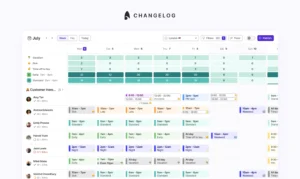
Round robin scheduling – tips for customer support

In customer support, if your team wants to be successful they have to be flexible, responsive, and knowledgeable to meet customers’ needs and gain their trust and loyalty. Support teams can manage their workload and equitably schedule each team member through a process called round robin scheduling.
In this blog post, we define round robin scheduling, explore its benefits, and provide best practices for using it effectively in a customer support environment.
What is round robin scheduling?
As it relates to team planning, round robin scheduling is a method of allocating work evenly among a group of individuals. It ensures that every team member has an equal opportunity to handle tasks or requests, or work certain shifts, and that no one is overburdened with too much work. Round robin scheduling works by sequentially assigning tasks to each team member, so that each person gets a turn to handle tasks or shifts in a cyclical manner.
In customer support specifically, round robin scheduling is used to distribute incoming customer requests or inquiries among the members of a customer support team. It prevents overload, which can lead to burnout and decreased productivity.
Why is round robin scheduling important for customer support teams?
Fair distribution of work
With round robin scheduling, every team member has an equal chance to handle tasks or requests. It handles requests in a cyclical manner, and is considered “one of the oldest, simplest, fairest and most widely used scheduling algorithms of all time”.
It ensures that no one is left out or overloaded with work, which can lead to frustration, stress, and burnout. By distributing work fairly, round robin scheduling ensures equality amongst teams.
Improved customer satisfaction
Customers expect a quick and efficient resolution to their problem when they reach out to customer support teams. Round robin scheduling ensures that customer requests are addressed in a timely manner, and that no customer is left waiting.
It also ensures that every customer gets an equal chance to interact with different team members, who may bring different perspectives or solutions to the table. This can lead to more comprehensive and effective solutions for customers, which can improve their overall satisfaction with the company.
Reduced burnout and improved morale
When team members are overloaded with work, they can become stressed and fatigued, leading to burnout and decreased productivity. Round robin scheduling helps to prevent burnout by distributing work fairly and ensuring that every team member has a reasonable workload. This improves team morale, motivation, and engagement, which translates into better performance and higher customer satisfaction.
Best practices for using round robin scheduling in customer support
1. Define your team’s availability
Before implementing round robin scheduling, it’s important to determine the availability of each team member. You don’t want to assign a task to a team member who is already swamped with other responsibilities.
Make sure that each team member is available and ready to take on new tasks before assigning them. You can use scheduling software to help you manage team member availability and ensure that tasks are assigned to the right people at the right time.
2. Set clear guidelines for task priority
It’s essential to establish clear guidelines for task priority, so that team members can quickly identify which tasks need to be handled first. You should define what constitutes high-priority tasks like urgent customer issues, and ensure that those tasks are addressed as quickly as possible. Implementing this into your round robins helps teams realise the benefits outline above.
3. Use software with round robin scheduling built-in
Surfboard’s round robin scheduling software fairly distributes shifts across team members. Whether it’s a weekend shift, morning shift, or even an unpopular Friday night shift, round robin scheduling means you can fairly share these working hours across your team, reducing burnout and increasing morale.
Check out our deep-dive into Surfboard’s round robin tools, or book a demo to explore our full suite of shift planning and WFM tools.



